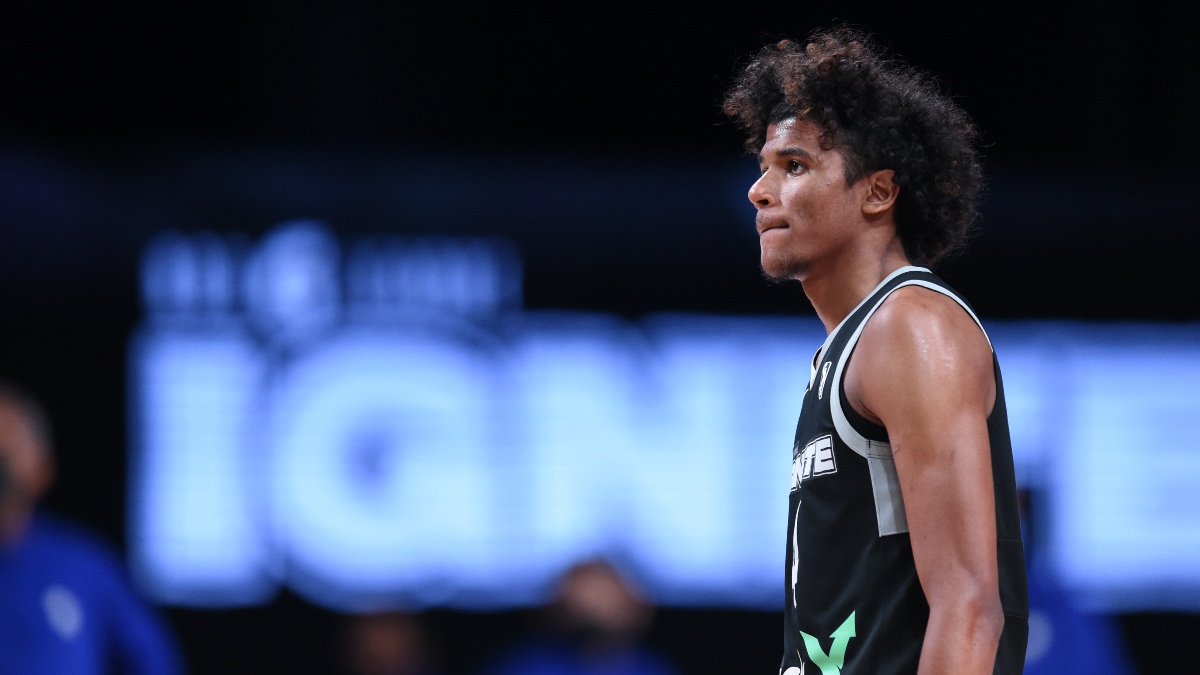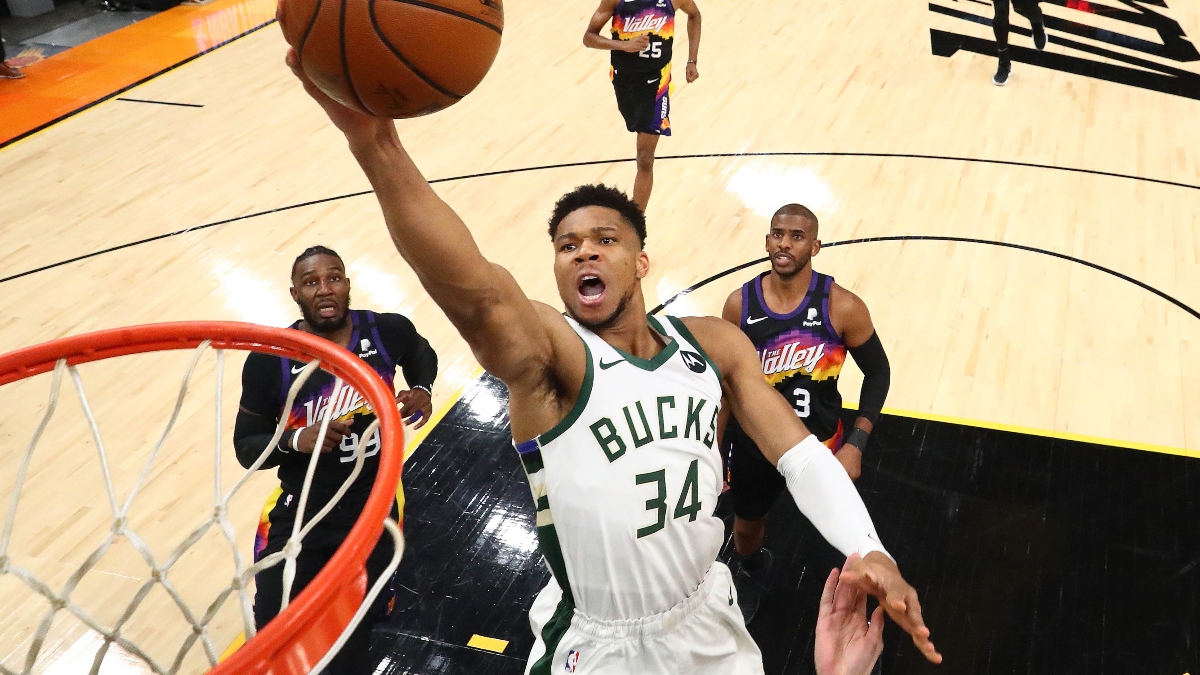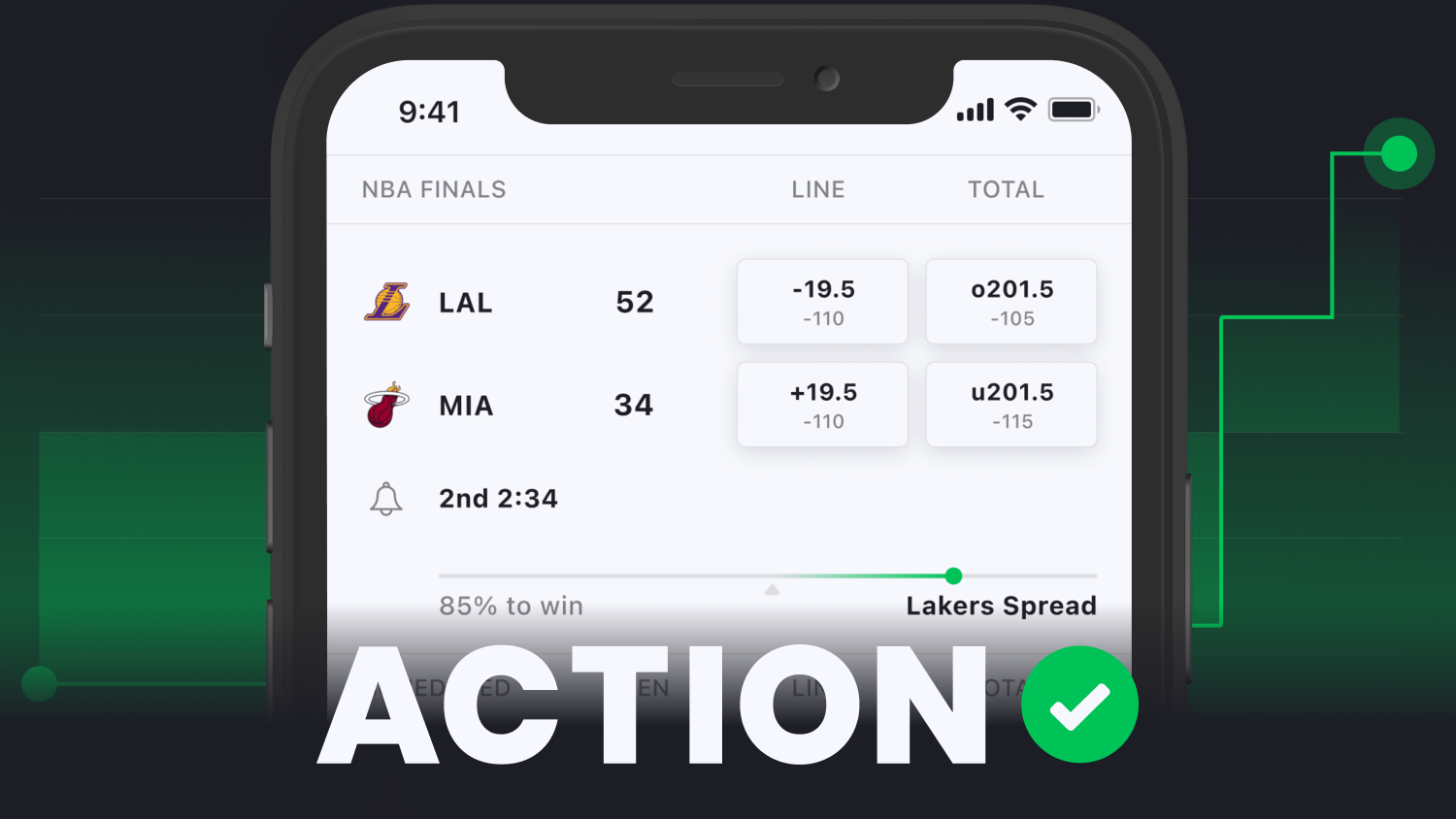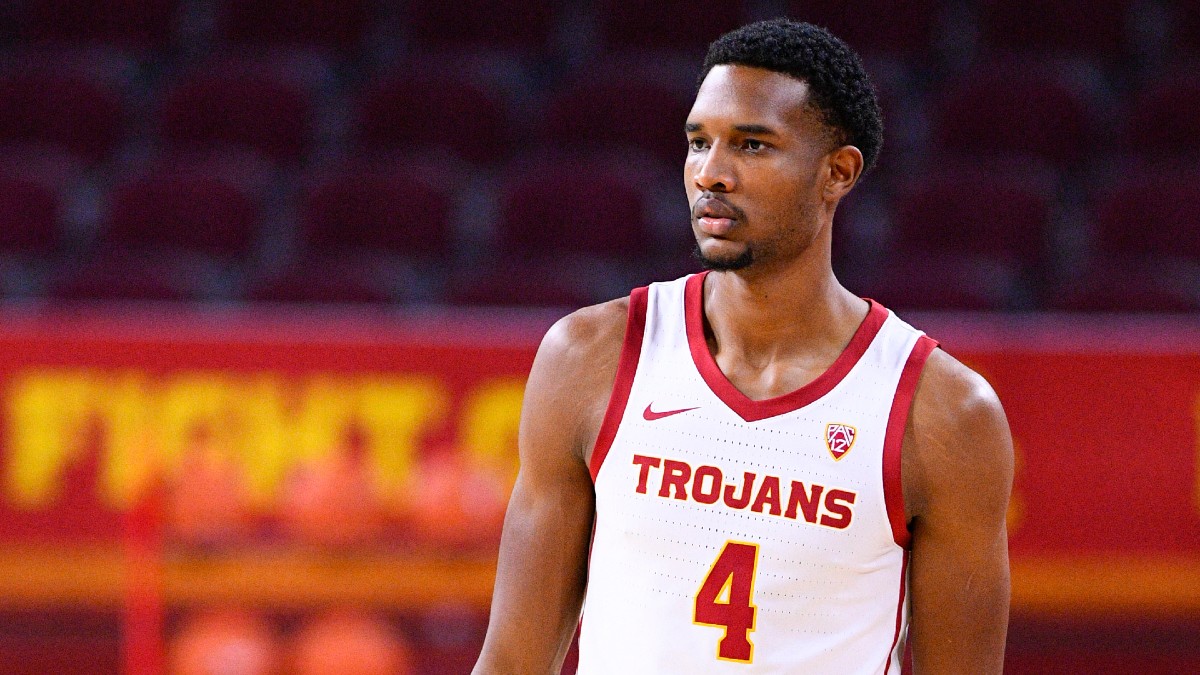
Juan Ocampo/NBAE via Getty Images. Pictured: Jalen Green.
Jalen Green NBA Draft Odds & Profile
| Position | Guard |
| School | G League Ignite |
| Height | 6’5″ |
| Age | 19 |
| Class | FR |
| Projected Pick (Odds) | No. 2 (-150) |
| Odds as of Thursday afternoon via BetMGM. | |
The NBA Draft is fast approaching, so it’s time to get to know the prospects at the top.
The Detroit Pistons won the 2021 NBA Draft Lottery and will select first, followed by the Houston Rockets, Cleveland Cavaliers and Toronto Raptors.
Oklahoma State’s Cade Cunningham remains a huge favorite to be drafted first, but the field is open after that. USC center Evan Mobley and Gonzaga guard Jalen Suggs are still very much in the mix, but for now, G League prospect Jalen Green has emerged as the front runner to go second.
Green didn’t play college basketball, so you might not have seen him play before the draft process. So, who exactly is Green and is he actually worthy of No. 2 overall hype?
Hyper-Athletic Guard in Kobe’s Mold
Close your eyes and imagine a classic NBA scoring two guard.
Think Bradley Beal, Zach LaVine, Devin Booker and… maybe Kobe Bryant. Got it? You have now imagined what Jalen Green hopes to become.
Green is a 6-foot-5 guard with a plus wingspan, and he’s a scorer through and through. He’ll play on the wing and attack the rim with his athleticism, plus he’s a three-level scorer who should fill up the box score.
He’s a young 19 years of age and electric athlete, boasting an incredible first step and explosive pop that should lend itself to an array of spectacular dunks.
Green is the same age as NBA prospects who just played their freshman year of college, but he didn’t play at that level. Instead, he played in the developmental G League for a new team called the Ignite.
That squad featured a mix of young prospects, including likely top-10 draft pick Jonathan Kuminga and first-round hopefuls Daishen Nix and Isaiah Todd, along with established NBA veterans like Jarrett Jack and Amir Johnson.
The goal of the Ignite was to showcase young players for the draft, while also paying them for their play — something that wasn’t legal for collegiate athletes before the recent NIL changes — and letting them be coached up in an NBA-like atmosphere.
On the one hand, that means we got far less time with Green. He played only 15 Ignite games, all in under a month. College athletes played twice that many, and we got to see them develop over five months instead of one. On the other hand, we got to see Green play against actual NBA-caliber players, including guys who’ve played in the league, while others like Jalen Suggs lined up against Northwestern State and Pepperdine.
It’s important to remember that context. Suggs played some of his games against guys you might play against at the YMCA. Green played against individuals like Kevin Porter Jr., Jordan Poole and Moses Brown, who got real NBA minutes to end the season.
So, how did Green fare against this increased athletic and skill competition?
Green’s Flashes of Excellence Impressed Most
Green’s numbers definitely stood out. He averaged 17.9 points per game, hitting 46% from the field. That’s an impressive 61% True Shooting, buoyed by 31 of 85 on 3s (37%) and an excellent 29 of 35 on free throws for an 83 percent clip.
In addition, Green added 4.1 rebounds, 2.8 assists and 1.5 steals per game, along with 2.7 turnovers. It’s a strong statistical profile for a guy playing with a bunch of professionals who had just turned 19 at the time. Even the advanced metrics for Green were solid and miles ahead of the other three draft prospects on the Ignite.
Still, while the numbers do hold up, it’s the flashes that stood out most for Green. And with prospects, it’s those flashes of upside that often matter most when projecting what a player might one day become.
The best game I saw Green play was against the Clippers. He showed advanced footwork on a step-back 3 and flashed explosive athleticism with a massive tomahawk dunk. Tune in to a Green game and he pops as the best athlete on the court. And remember, that’s on a court full of other NBA athletes. He has that electric first step, quick-footed jump and violent explosion attacking the rim.
Against Memphis, Green missed a lot of shots, but flashed his ability to impact the game without scoring. He again displayed advanced footwork on jumpers and going at the rim, with his first step constantly helping him burst past opposing defenders. Green also showed off his passing ability with a couple excellent pick-and-roll read pocket passes.
Against Oklahoma City, Green popped athletically on the glass with an impressive block. Against Erie, he had another athletic block and an impressive end-to-end layup. In a playoff game against the Raptors, Green showed a hang dribble with advanced step-back footwork, along with improved passing and decision making.
The flashes, which were there all season, were impressive. However, it’s that last part that impressed most — the marked improvement Green showed over just one month of development in the G League.
_BookPromo=821
Green’s Strong Development Curve Bodes Well
The difficulty with scoring guards is they typically have a long developmental curve.
Devin Booker and Bradley Beal were not chosen as All-Stars until their sixth seasons, at age 24. Zach LaVine just made his first All-Star team in his seventh year. It takes a long time for this archetype to hit, which is why it’s so important Green already showed such an impressive developmental curve.
Early on, Green underwhelmed. It was actually his teammate — Jonathan Kuminga — who impressed early and even had some No. 1 pick buzz.
Green popped athletically in those early games, but looked lost at times, especially on defense. He totally lost his man on a cut on the first play of his career and didn’t look engaged. In his second game, he was blown by all game, with lots of fake effort on defense.
I also saw a thin frame with long, skinny legs with a real lack of playing strength. Green got driven on by Nico Mannion (not good) and I didn’t love his handle early. He showed a loose dribble and had some early turnovers, plus he kept getting the ball ripped off him.
Early on, I had real questions about Green — not just as a potential No. 1 pick — but as a top-five prospect at all. He struggled to make an impact, with the flashes were few and far between.
That’s what makes Green’s improvement over that month so impressive. He caught his sea legs as the season went along, found his place and really looked better as he settled in. Those flashes above? They came in the back half of the season and that’s good. It’s perfectly fine for a teenager to take a couple weeks to find his feet against grown men when he looks that good once he gets there.
That Clippers game that was the best I saw from Green all year came in the final week of the season. The Ignite were the last team into the playoffs, and Green looked like the most talented player on the court in his one playoff game.
He had a huge third quarter to keep the Ignite alive, flashing electric three-level scoring ability with a hang dribble and step-back footwork. He also displayed an improved ability to get those tough playoff buckets we’ve come to expect from this archetype, finishing through contact and hitting contested pull-ups when things broke down.
That’s the Green some team will draft. That Jalen Green is worth the wait.
_BookPromo=317
Green’s Upside Makes Him Worthy of Top Pick
Green probably isn’t a top-five player in this draft right now, but the NBA Draft is about what players will become, not what they are at the moment.
And in a league desperate for wings and shot makers, the player we imagine Green might one day become is absolutely worth a top-five draft pick or even higher.
Green isn’t perfect. He badly needs to strengthen his frame and improve finishing at the rim. Right now, he contorts from contact instead of finishing through it. Green also struggles to create for others. He’s more of a self-made scorer. And I’m not in love with the shot form. Green’s elbows flair out and there appears to be a hitch in the shot.
Still, the results speak for themselves — 37% on 3-pointers and 83% free throws — and those flashes are really good. Green will be an explosive standout athlete, even against NBA peers, and he’s a three-level scorer who can get his when everything breaks down.
That’s one of the most valuable, most difficult to find skill sets. Green can dribble, pass and shoot. He even has defensive upside with his athleticism if he properly engages.
Green isn’t the perfect player, but he’s the whole package as a prospect and that’s what matters most right now.
This won’t be easy. Remember, it often takes until year six or seven for players of this type to be truly valuable. A team drafting Green shouldn’t hope for an early contribution. He’s a long-term project, and likely a negative player early on as he grows. Green probably won’t be a valuable contributor until he’s on his second NBA contract.
However, Green’s upside, development and projection are what make him a clear top-five pick, even if his archetype and longer development curve slightly limit him, putting him in a tier behind Cunningham and Mobley.
For now, Green’s dazzling upside keeps him in the running as high as No. 2 overall. We’ll see if he stays there as he heads to Houston for the draft.
_BookPromo=405


